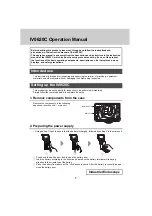
18
CFM
CFM
• After the third calibration point is confirmed, immerse the pH electrode and the
temperature probe approximately 4 cm (1½”) into the fourth buffer solution
and stir gently. The temperature probe should be close to the pH electrode.
• If necessary, press the
ARROW
keys to select a different buffer value.
• The “ ” tag will blink on the LCD until the reading is stable.
• When the reading is stable and close to the selected
buffer, “CFM” tag blinks.
• Press
CFM
to confirm calibration.
• The calibrated value is then displayed on the
primary LCD and the secondary LCD will display the
fifth expected buffer value.
• After the fourth calibration point is confirmed, immerse the pH
electrode and the temperature probe approximately 4 cm (1½”) into
the fifth buffer solution and stir gently. The temperature probe should
be close to the pH electrode.
• If necessary, press the
ARROW
keys to select a different buffer value.
• The “ ” tag will blink on the LCD until the reading is stable.
• When the reading is stable and close to the selected
buffer, “CFM” tag blinks.
• Press
CFM
to confirm calibration.
• The instruments store the calibration values and
return to normal measurement mode.
FOUR, THREE or TWO-POINT CALIBRATION
• Proceed as described in “FIVE-POINT CALIBRATION” section.
• Press
CAL
after the appropriate accepted calibration point. The instruments
will return to measurement mode and will memorize the calibration data.
ONE-POINT CALIBRATION
Two SETUP selectable options are available: “Pnt” and “OFFS”.
If the “Pnt” option is selected, the adjacent slopes will be reevaluated.
If the “OFFS” option is selected, an electrode offset correction is performed
keeping unchanged the existing slopes.
• Proceed as described in “FIVE-POINT CALIBRATION” section.
• Press
CAL
after the first calibration point was confirmed. The instruments
will memorize the one-point calibration data and will return to measure-
ment mode.
Notes:
• Press
MODE
or / from the left keyboard to toggle between
pH buffer and temperature reading during calibration.
• Each time a buffer is confirmed, the new calibration parameters
replace the old calibration parameters of the corresponding buffer.
If current confirmed buffer has no correspondence in the existing
stored calibration and this is not full, the current buffer is added
to the existing stored calibration.
















































